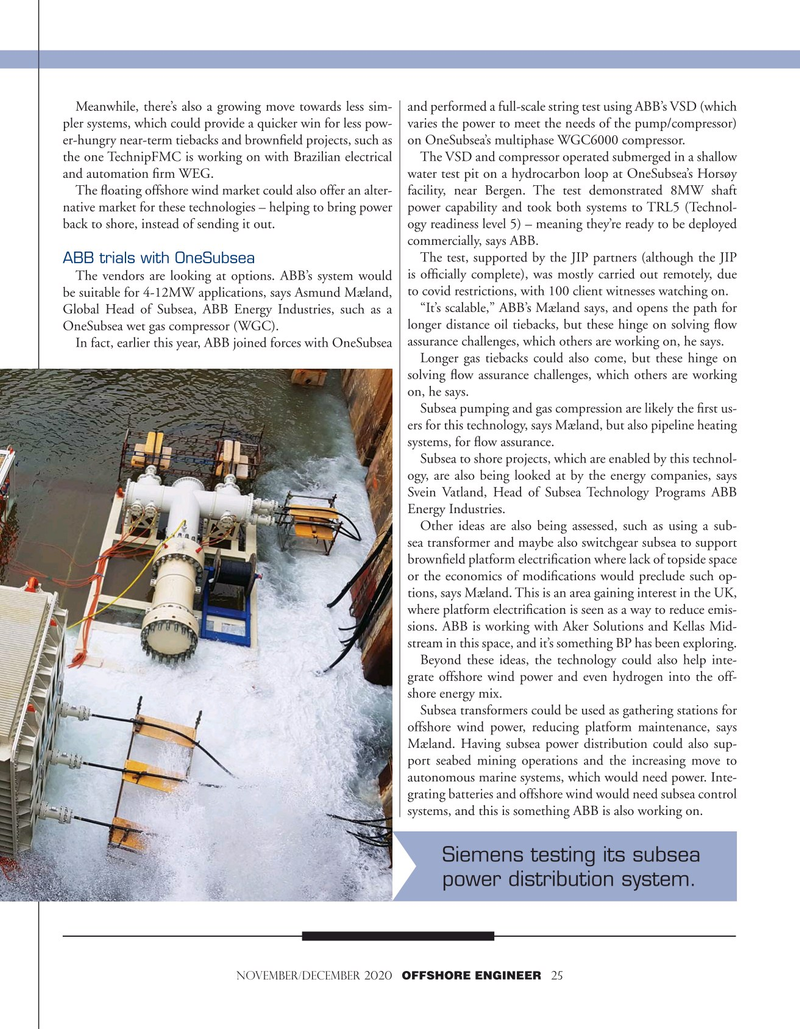
Page 25: of Offshore Engineer Magazine (Nov/Dec 2020)
Read this page in Pdf, Flash or Html5 edition of Nov/Dec 2020 Offshore Engineer Magazine
Meanwhile, there’s also a growing move towards less sim- and performed a full-scale string test using ABB’s VSD (which pler systems, which could provide a quicker win for less pow- varies the power to meet the needs of the pump/compressor) er-hungry near-term tiebacks and brown?eld projects, such as on OneSubsea’s multiphase WGC6000 compressor. the one TechnipFMC is working on with Brazilian electrical The VSD and compressor operated submerged in a shallow and automation ?rm WEG. water test pit on a hydrocarbon loop at OneSubsea’s Horsøy
The ?oating offshore wind market could also offer an alter- facility, near Bergen. The test demonstrated 8MW shaft native market for these technologies – helping to bring power power capability and took both systems to TRL5 (Technol- back to shore, instead of sending it out. ogy readiness level 5) – meaning they’re ready to be deployed commercially, says ABB.
The test, supported by the JIP partners (although the JIP
ABB trials with OneSubsea
The vendors are looking at options. ABB’s system would is of?cially complete), was mostly carried out remotely, due be suitable for 4-12MW applications, says Asmund Mæland, to covid restrictions, with 100 client witnesses watching on. “It’s scalable,” ABB’s Mæland says, and opens the path for
Global Head of Subsea, ABB Energy Industries, such as a longer distance oil tiebacks, but these hinge on solving ?ow
OneSubsea wet gas compressor (WGC).
In fact, earlier this year, ABB joined forces with OneSubsea assurance challenges, which others are working on, he says.
Longer gas tiebacks could also come, but these hinge on solving ?ow assurance challenges, which others are working on, he says.
Subsea pumping and gas compression are likely the ?rst us- ers for this technology, says Mæland, but also pipeline heating systems, for ?ow assurance.
Subsea to shore projects, which are enabled by this technol- ogy, are also being looked at by the energy companies, says
Svein Vatland, Head of Subsea Technology Programs ABB
Energy Industries.
Other ideas are also being assessed, such as using a sub- sea transformer and maybe also switchgear subsea to support brown?eld platform electri?cation where lack of topside space or the economics of modi?cations would preclude such op- tions, says Mæland. This is an area gaining interest in the UK, where platform electri?cation is seen as a way to reduce emis- sions. ABB is working with Aker Solutions and Kellas Mid- stream in this space, and it’s something BP has been exploring.
Beyond these ideas, the technology could also help inte- grate offshore wind power and even hydrogen into the off- shore energy mix.
Subsea transformers could be used as gathering stations for offshore wind power, reducing platform maintenance, says
Mæland. Having subsea power distribution could also sup- port seabed mining operations and the increasing move to autonomous marine systems, which would need power. Inte- grating batteries and offshore wind would need subsea control systems, and this is something ABB is also working on.
Siemens testing its subsea power distribution system.
November/December 2020 OFFSHORE ENGINEER 25

 24
24

 26
26